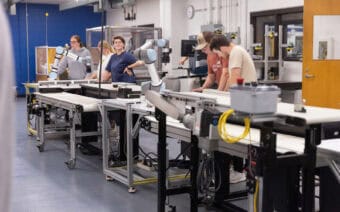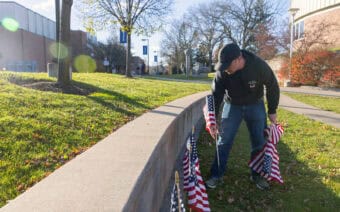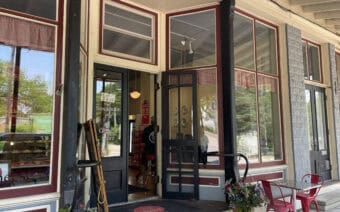
March 18, 2024
EAU CLAIRE – In an emergency, being able to make decisions under pressure in moments of distress is critical.
Thanks to Chippewa Valley Technical College’s (CVTC) new Emergency Service Simulation Center, students in the criminal justice, law enforcement academy, EMT and firemedic programs now have access to hands-on, real-life training experiences to prepare them for those situations.
Located on the college’s west campus (3623 Campus Road), Eric Anderson, associate dean of Emergency Services at CVTC, said the new center will help students have a better idea of what real-life scenarios in their future jobs could look like.
“A lot of the scenarios we do (in these programs) are all live scenarios,” he said. “What we want to have is a realistic venue for them to go into a situation and be able to respond appropriately and correctly.”
Before the simulation center, Anderson said instructors would use classrooms – or several depending on the scenario – and pretend it was in a realistic setting.
“It doesn’t get the student into the mindset where they need to be,” he said. “They feel like it’s artificial… (And) we’ve taken up four or five classrooms that could be used for other purposes. We needed a space where we could have multiple scenarios occurring at the same time in realistic situations.”
With the new Emergency Service Simulation Center, Anderson said the college can now do that.
About the center
The simulation center has multiple different rooms so each program can go through realistic scenarios related to them – such as a one-bedroom apartment, a bar, a motel room and a doctor’s office.
The building, Anderson said, is “usable and durable.”
“It’s all concrete floors, and we have plywood walls,” he said. “Our contractor gave us some nice paint colors in there, so it looks nice, even though the walls are made of plywood.”
Rooms in the center, Anderson said, can be converted to fit the specific needs of each program.
For example, for the FireMedic program, he said the windows are blacked out, mannequins or “victims” of the fire will be placed throughout the building and it will be filled with artificial smoke.
“Then, we’ll send a firefighter in there, in all of their gear, to try to locate all the victims in the building,” he said.
For paramedics and EMTs, Anderson said they can create “any medical emergency you could think of.”
“Say somebody has a cardiac arrest in the doctor’s office, or… somebody is in their apartment, and now we’re called to a non-responsive person,” he said. “EMTs come in and they do an assessment – there’s a person on the floor, in the living room, on the couch, in the bed.”
Anderson said according to the paramedics CVTC has worked with, one of the more common places to find people is lodged between the toilet and the wall.
“A lot of people have a cardiac arrest or a stroke or something happens on the toilet and they fall off and get stuck between the toilet and the wall,” he said. “It’s a realistic challenge we’ve been told (by those in the profession) occurs a lot, so (now we can teach) how to extract somebody from that situation.”
When it comes to criminal justice, Anderson said “the sky’s the limit” for the type of scenarios they can reenact for students.
CVTC’s Law Enforcement Academy scenario final lasts for an entire week – five, eight-hour days.
“They’ll go through a variety of situations – whether that is a person unresponsive, a domestic disturbance, a burglary – I mean any kind of case – we will send them to,” he said. “They engage with the people, use their professional communication skills, walk inside and handle the emergency. (The center) gives them that realistic mindset to get into that and put them into that world.”
Meeting community needs, too
Not only does the center now fulfill students’ needs, but Anderson said the simulation building could also meet the needs of local organizations.
“I’ve gotten so many emails and phone calls from departments around here, whether that’s police departments or fire departments (that) want to come in and do the same (scenarios) for their people for continuing education,” he said.
Anderson said even SWAT teams have contacted him, “itching to get into the building.”
“We have so many different entrances and doors,” he said. “ We can change things up inside so it looks different, so they’re not going through the same building (with different configurations).”
Canine trainers, Anderson said, have also contacted him to use the space.
“(The simulation center) is meeting the purpose we had intended for it,” he said.
Since the center opened a few weeks ago, Anderson said CVTC does not have any partnerships as of yet but hopes to see them start coming around.
Students are ‘amazed’
So far, Anderson said, students “are anxious to get out there.”
“We’ve had some classes go out there already,” he said. “When I walk in there with the students and I open the doors, they’re amazed at what it looks like… They’re amazed, especially with the bar or the apartment – the apartment is amazing. I would live there. It’s nice and looks real.”
Without the generosity of a private, anonymous donation, as well as donated furniture from the college’s staff, Anderson said the simulation center would not have been possible.
“We put out an all-staff message to (ask for donations) – old furniture, coffeemakers, microwaves, plates, artwork,” he said. “Our community within CVTC loaded us up with all kinds of stuff, and we were able to furnish it at zero cost to the college.”
As students, faculty and the community continue to use the Emergency Service Simulation Center, Anderson said “it’s a great addition to this campus.”
“We will be using it (long) in the future,” he said.
To learn more about CVTC and its simulation center, follow its Facebook page.
 FVTC, Children’s Wisconsin partnership supports Go Baby Go in the Fox Valley
FVTC, Children’s Wisconsin partnership supports Go Baby Go in the Fox Valley High-water mark: Appleton tap water named state’s tastiest
High-water mark: Appleton tap water named state’s tastiest








